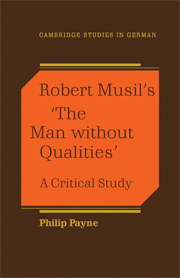Book contents
1 - Impressions of Musil seen from within
Published online by Cambridge University Press: 04 August 2010
Summary
In 1939 Musil's head was modelled in clay by the sculptor, Fritz Wotruba. Wotruba was thus in a unique position to study him, at least from without. These are his impressions: ‘[He was] a handsome man with a powerful and well-proportioned body […]. His manner was that of an Austrian gentleman of the old school, his skull and build were typically Slavic, his fine head, set on a thick neck, had an air of fatigue.’ Others were less struck by physical attributes – for them the charm of old Austria, the fastidiousness of the man in matters of dress and hygiene, were only superficial. What mattered was more the special psychic signature. Hans Mayer wrote: ‘In discussion, as in every movement he made, Musil conveyed a sense of strain. Every verbal exchange with him was forced.’ A close friend, the psychologist Johannes von Allesch, records the ‘enormous […] intensity which Musil expended in attempts to grasp both things and events firmly in his mind’. Wolfdietrich Rasch, too, registers ‘the vibrations of a highly responsive sensibility […], sceptical, tensed […] to register answers to passionate questions, ceaselessly on the alert’. Rasch takes us from objective to subjective mode, from Musil seen from without to Musil seen from within. The evidence of Musil's inner life is to be found in his Tagebücher.
Musil's diaries are records of the ‘subject’ in the sense in which Schopenhauer talks about the world as being ‘object-for-the-subject’, in other words a place which only exists in so far as a consciousness is there to observe it.
- Type
- Chapter
- Information
- Robert Musil's 'The Man Without Qualities'A Critical Study, pp. 3 - 14Publisher: Cambridge University PressPrint publication year: 1988



